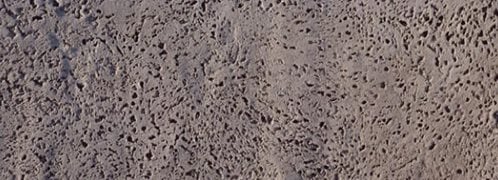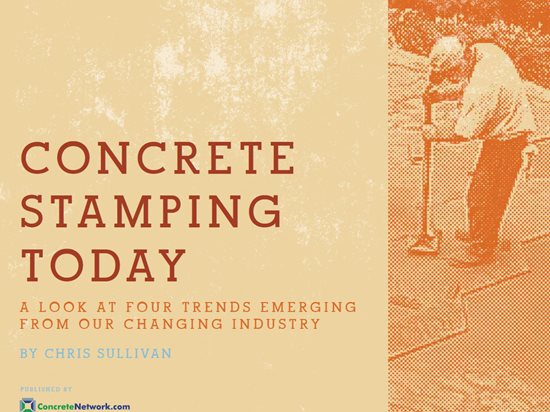- Concrete Stamps
- Get the Look - Stamping Pictures
- Buying Tips for Concrete Stamping Tools: Advice that will help you make smart choices
- Concrete Stamp Cost
- Types of Concrete Stamps: A comparison chart of popular stamps & patterns
- Stamping & Texturing Tools
- Concrete Stamp Mats
- Concrete Texturing Skins
- Medallion Stamps
- Texture Rollers
- Step Forms & Liners
- Installing Stamped Concrete
- How to Stamp Concrete
- Coloring Stamped Concrete
- Concrete Stamp Release Agent
- Sealers for Stamped Concrete
Pricing Trends for Stamped Concrete
How to stay profitable in today’s competitive marketplaceThis is an excerpt from the new e-book “Concrete Stamping Today,” part of a series of reports from ConcreteNetwork.com on trends and insights about decorative concrete applications.
Free E-book:
Concrete Stamping Today
Discover four emerging trends in concrete stamping from ConcreteNetwork.com’s new e-book. You’ll also get insights and advice from veteran installers that will help you stay profitable in today’s market.
Download Concrete Stamping Today (PDF)
Price points, and how to keep stamped concrete profitable, are often at the top of the list of concerns for stamped concrete installers today. The price per square foot of stamped concrete has held steady or come down, and the cost of everything going into making that square foot of stamped concrete has gone up. “When we started stamping concrete in 2004, I was getting $12 per square foot comfortably. Today, I have to fight to get $12 per square foot, and often have to come down in price if I really want the job,” says C.J. Salzano of Salzano Custom Concrete, Centreville, Va. The constant struggle for installers is how to maintain profits in an industry that has seen constant price pressure from low bidders and raw material price increases.
There are markets in the United States where stamped concrete is installed for as little as $4 per square foot. “Unfortunately, because of our stagnant economy over the past several years, I have seen the unit square foot price of stamping work dramatically decline. That’s not to say the high-end guys aren’t able to demand their price, I’m talking generally,” says Bob Harris of the Decorative Concrete Institute, Temple, Ga. These pressures are real, and they have real consequences. The last four years have seen a significant number of concrete installers get out of stamped concrete or shut down completely. Even more have had to lay off workers or cut benefits. So how do you combat this trend? Here, stamped concrete installers share some of their strategies.
Differentiate your productTo make a profit in today’s marketplace, you can either increase volume, which is hard to do in a tough economic and competitive climate, or you can differentiate yourself and your product so you can ask a higher price. The latter is the approach that most successful stamped concrete installers have embraced. Price pressure is one of the leading factors in the trend of installing unique and different stamped concrete finishes. “We have had to come up with new and different looks to get higher margins,” says Brad Walker of Lone Star Concrete Systems, Watauga, Texas.
The market is split between those installers who sell on price and offer a non-specific style of stamped concrete, and those that offer a unique and different look, which demands a higher price. Quality is not necessarily the issue, as both can offer a high level of quality. It all comes down to selling the added value and creating a unique style or brand that brings a higher price.
Expand your marketOutdoor living spaces have become a trend in recent years. The days of a simple concrete patio with a few chairs and table are gone, replaced by outdoor living spaces complete with “rooms” for cooking, eating, socializing, and just plain relaxing. These outdoor living spaces often include kitchens, water features, fireplaces or fire pits, and built-in concrete benches and seat walls (see Outdoor Living and Backyard Ideas).
Stamped concrete plays a big role in this new trend, and Chris Becker of Becker Architectural Concrete, Minneapolis. Minn., has jumped on it. A few years ago, his business offered stamped concrete as a stand-alone option for homeowners or designers. “We provided high-end stamped concrete, and that was all. We would watch as it was being incorporated into the larger theme and design of a backyard or outdoor living space,” he says. It wasn’t long before Becker realized that the stamped concrete could be the centerpiece on which the entire outdoor living space could revolve, and now he uses this as an upsell when working with clients. Today, Becker Architectural Concrete will not only provide you with a high-end stamped concrete patio or pool deck, but also make it part of an entire outdoor living space. “We start with the stamped concrete, and very quickly we are talking about concrete countertops for the bar or outdoor kitchen as well as a concrete fireplace hearth and surround,” he says. Everything is designed to work with and around the stamped concrete.
More and more traditional stamped concrete installers are starting to offer these expanded services to create multifunctional outdoor living spaces. In some cases, the stamped concrete installer will perform all the work themselves, while others will sub out the work they are not capable of performing. These outdoor living areas increase the home’s value and take advantage of spaces that were often overlooked.
The most popular colors for stamped concrete in these outdoor rooms are lighter earth tones blended into large, lightly textured flagstone or tile patterns. “People want stamped concrete to look like natural stone or tile. They want a $30-square-foot look for $12. Stamped concrete can provide this,” says Salzano, owner of Salzano Custom Concrete, Centreville, Va.
Generate a new revenue streamWalker also takes stamped concrete to a new level by targeting the homebuilder. He has established a new revenue stream by selling stamped concrete as an upgrade for these otherwise tract homes. “We worked hard for one year to get in with certain homebuilders in our area. These builders now offer stamped concrete as an upgrade on every mid- to upper-end home they sell,” he says. The message that Walker conveyed to builders is that stamped concrete is a hardscape that adds value to the home. The other great outcome of offering this upgrade option is that once one house gets a stamped concrete driveway or patio, all the neighbors like it so much they want stamped concrete as well. It took Lone Star Concrete a lot of time and energy upfront, but now that they are in with a few builders, installing stamped concrete as part of a residential housing development has led to big profits.
Don’t give your work awayThe historical trend with stamped concrete has been a slow but steady erosion of prices. This is not unlike many other specialty products that rise in market recognition quickly, and then see a flood of competition that causes rapid price erosion. This price erosion has moderated in recent years, and in most markets prices are steady. As the economy rebounds and inflationary pressures increase, the base price of stamped concrete will probably rise. When and how much are better left to the economists to examine. What we do know is that stamped concrete is a product in demand and will be even more so as the market recovers. “Despite today’s tough times, I feel strongly about holding your ground and not giving your work away,” says Harris.
It is the responsibility of the industry, and especially the installer, to produce a quality product sold at a fair price. If price erosion gets too severe, quality suffers, the market as a whole is damaged, and no one wins. In contrast, the best-case scenario is where the industry continues to generate unique and high-quality work, which raises the level of the industry overall. This allows prices to increase based on demand, making for a strong and bright future for stamped concrete.
 Ashlar Cut Slate Stamp
Hand-tooled with a pronounced texture
Ashlar Cut Slate Stamp
Hand-tooled with a pronounced texture
 Herringbone Used Brick
Tool Size is 44" x 27"
Herringbone Used Brick
Tool Size is 44" x 27"
 Rock Salt
Seamless travertine off-set
Rock Salt
Seamless travertine off-set
 Bluestone Texturing Skin
6 skin set - only $1,173.20
Bluestone Texturing Skin
6 skin set - only $1,173.20
 Five Point Star Medallion
Concrete stamp only - $292.00
Five Point Star Medallion
Concrete stamp only - $292.00
 Brickform Stamping Tools
Precision stamping tools
Brickform Stamping Tools
Precision stamping tools





